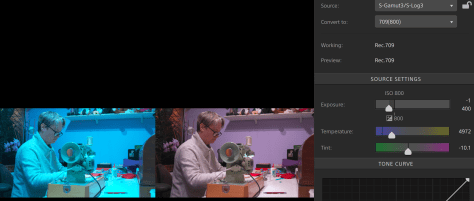This is a very good question that came up in one of the F5/F55/FX9 facebook groups that I follow. The answers are also mostly relevant to users of the FX6, FX3 and the A7SIII.
There were two parts to it: Is the FX9’s raw out as good as the raw from the F5/F55 and then – do I really need raw.
In terms of image quality I don’t think there is any appreciable difference, going between the raw from an FX9 and the raw from an F5/F55 is a sideways step.
The F5/F55 with either Sony Raw or X-OCN offer great 16 bit linear raw in a Sony MXF package. The files are reasonably compact, especially if you are using the R7 and X-OCN. There are some compatibility issues however and you can’t use the Sony Raw/X-OCN in FCP-X and the implementation in Premier Pro is poor.
The 16 bit out from the FX9/XDCA-FX9 gets converted to 12 bit log raw by the Atomos recorders, currently the only recording options – but in reality you would be extremely hard pushed to really see any difference between 16 bit linear raw and 12 bit log raw from this level of camera.
Recording the 12 bit log raw as ProRes Raw means that you are tied to just FCP-X, Premiere Pro (poor implementation again) and Scratch. The quality of the images that can be stored in the 2 different raw formats is little different, 16 bit linear has more code values but distributed very inefficiently. 12 bit log raw has significantly fewer code values but the distribution is far more efficient. AXS media is very expensive, SSD’s are cheap. AXS card readers are expensive, SSD adapters are cheap. So there are cost implications.
Personally I feel the reduced noise levels from the FX9 makes footage from the FX9 more malleable than footage from the F5/F55 and if you are shooting in FF6K there is more detail in the recordings, even though they are downsampled to 4K raw. But the FF6K will have more rolling shutter compared to an F55/F5.
Working with Sony Raw/X-OCN in Resolve is delightfully easy, especially if you use ACES and it’s a proper grading package. If you want to work with ProResRaw in Resolve you will need to use Apple Compressor or FCP-X to create a demosaiced log file, which even if you use ProRes444 or XQ not the same as working from the original raw file. For me that’s the biggest let down. If I could take ProResRaw direct into Resolve I’d be very happy. But it is still perfectly possible to get great footage from ProResRaw by transcoding if you need to.
As to whether you need raw, only you can answer that fr yourself. There are many factors to consider. What’s your workflow, how are you delivering the content. Will the small benefit from shooting raw actually be visible to your clients?
Are you capturing great content – in which case raw may give you a little more, or are you capturing less than ideal material – in which case raw isn’t going to be a get out of jail card. Raw of any flavour works best when it’s properly exposed and captured well.
I would suggest anyone trying to figure out whether they need raw or not to start by to grading the XAVC-I from the FX9 and see how far you can push that, then compare it to the raw. I think may be surprised by how little difference there is, XAVC-I S-Log3 is highly gradable and if you can’t get the look you want from the XAVC-I raw isn’t going to be significantly different. It’s not that there is anything wrong with raw, not at all. But it does get rather over sold as a miracle format that will transform what you can do. It won’t perform those miracles, but if everything else has been done to the highest possible standards then raw does offer the very best that you can get from these cameras.
As a middle ground also consider non raw ProRes. Again the difference between that and XAVC-I is small, but it may be that whoever is doing the post production finds it easier to work with. And the best bit is there are no compatibility issues, it works everywhere.
But really my best recommendation is to test each workflow for yourself and draw your own conclusions. I think you will find the differences between each much smaller than you might assume. So then you will need to decide which works for you based on cost/effort/end result.
Sometimes best isn’t always best! Especially if you can get to where you need to be more easily as an easy workflow gives you more time to spend on making it look the way you want rather than fussing with conversions or poor grading software.
 Atomos have release a firmware update for the Shogun 7 to correctly implement raw recording from the FX6 at up to 60fps.
Atomos have release a firmware update for the Shogun 7 to correctly implement raw recording from the FX6 at up to 60fps.


